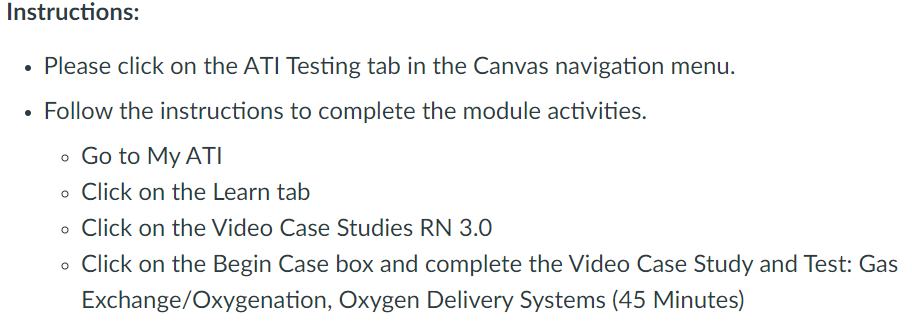NUR105 M3.7: ATI-Video Case Studies: Gas Exchange/Oxygenation, Oxygen Delivery Systems
Question: A nurse is assessing a client who is receiving oxygen via a partial rebreather mask at 10 L/min. When auscultating the lungs, the nurse should monitor for which of the following findings as an indication of oxygen toxicity?NUR105 M3.7: ATI-Video Case Studies
Answer: Crackles.
Explanation: Crackles can be an indication of oxygen toxicity, especially in clients receiving high oxygen concentrations for an extended duration. Symptoms of oxygen toxicity may include dyspnea, gastrointestinal distress, and chest pain.
Question: A nurse in a long-term facility is planning care for a client who is to receive oxygen at 4 L/min via a nasal cannula. Which of the following interventions should the nurse include in the plan of care?
Answer: Provide the client with oral care every 8 hrs.NUR105 M3.7: ATI-Video Case Studies
Explanation: Clients receiving oxygen through nasal cannulas often breathe through their mouths, leading to dry and irritated mucous membranes. Providing oral care helps alleviate this issue.
Question: A nurse is planning care for a client who requires an exact concentration of oxygen. Which of the following oxygen delivery systems should the nurse use?
Answer: Venturi Mask .NUR105 M3.7: ATI-Video Case Studies
Explanation: The Venturi mask is capable of delivering precise oxygen concentrations, ranging from 24% to 50% FiO2, depending on the flow rate, making it suitable for clients who require specific oxygen concentrations.
Question: A nurse is caring for a client who is receiving oxygen at 8 L/min through a simple face mask. The nurse should identify that the client is able to receive which of the following concentrations of oxygen with a simple face mask?NUR105 M3.7: ATI-Video Case Studies
Answer: 40%
Explanation: A client receiving oxygen via a simple face mask at a flow rate of 5 to 8 L/min can expect to receive oxygen at a concentration of 40% to 60%.
Question: A nurse is caring for a client who is 1 hour postoperative following an open cholecystectomy with general anaesthesia. The nurse should monitor for which of the following findings as an indication of hypoxia?
Answer: Cyanotic Mucous Membranes
Explanation: Postoperative clients, especially those who have undergone general anaesthesia, are at risk of hypoxia due to factors such as respiratory depression. Monitoring for cyanotic mucous membranes, confusion, restlessness, tachycardia, and dyspnea is crucial in detecting signs of decreased gas exchange.
For anyone seeking ATI TEAS prep or online tutoring for nursing, I encourage you to consider our services at fixmygpa.com. We provide expert guidance and support to help you excel in your nursing education and prepare for important exams like the ATI TEAS. Our team is dedicated to helping you achieve your goals and thrive in your nursing career. Don’t hesitate to reach out for the support you need to succeed!



